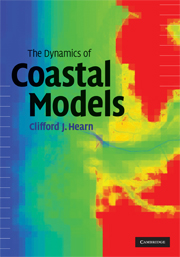Book contents
- Frontmatter
- Contents
- Preface
- Acknowledgements
- Note on mathematics and model codes
- 1 Prelude to modeling coastal basins
- 2 Currents and continuity
- 3 Box and one-dimensional models
- 4 Basic hydrodynamics
- 5 Simple hydrodynamic models
- 6 Modeling tides and long waves in coastal basins
- 7 Mixing in coastal basins
- 8 Advection of momentum
- 9 Aspects of stratification
- 10 Dynamics of partially mixed basins
- 11 Roughness in coastal basins
- 12 Wave and sediment dynamics
- References
- Index
- References
6 - Modeling tides and long waves in coastal basins
Published online by Cambridge University Press: 18 December 2009
- Frontmatter
- Contents
- Preface
- Acknowledgements
- Note on mathematics and model codes
- 1 Prelude to modeling coastal basins
- 2 Currents and continuity
- 3 Box and one-dimensional models
- 4 Basic hydrodynamics
- 5 Simple hydrodynamic models
- 6 Modeling tides and long waves in coastal basins
- 7 Mixing in coastal basins
- 8 Advection of momentum
- 9 Aspects of stratification
- 10 Dynamics of partially mixed basins
- 11 Roughness in coastal basins
- 12 Wave and sediment dynamics
- References
- Index
- References
Summary
Introduction
This chapter provides some background into our understanding and modeling of astronomical tides in coastal basins. We provide some simple models that illustrate some of the basic scientific ideas and methodology models of tides and long waves. We finish the chapter with some general comments on the way that we build spatial grids for numerical models.
Astronomical tides
Origin of tides
The astronomical tides of the ocean are primarily due to changes in the gravitational potential exerted on the large ocean basins by the Moon and Sun as the Earth rotates in their gravitational fields. These are called astronomical tides by oceanographers. The word tide in common parlance refers to any movement of ocean water or change in ocean state. Thus, we find the noun tide being used to describe phenomena in the coastal ocean, such as the state and direction of currents important to maritime operations, water height and also red tides, rip tides, etc., and there are many etymological links between the words tide and time. In oceanography tide is used in general to refer to any periodic changes in water level and the associated current; these may be due to astronomical forcing or to other processes, such as periodic winds. However, oceanographers often use the term tides as a synonym for astronomical tides, since these tides are a dominant feature of the world's oceans. There has been an attempt to tidy up, within earth sciences, the use of the word tide.
- Type
- Chapter
- Information
- The Dynamics of Coastal Models , pp. 176 - 227Publisher: Cambridge University PressPrint publication year: 2008



